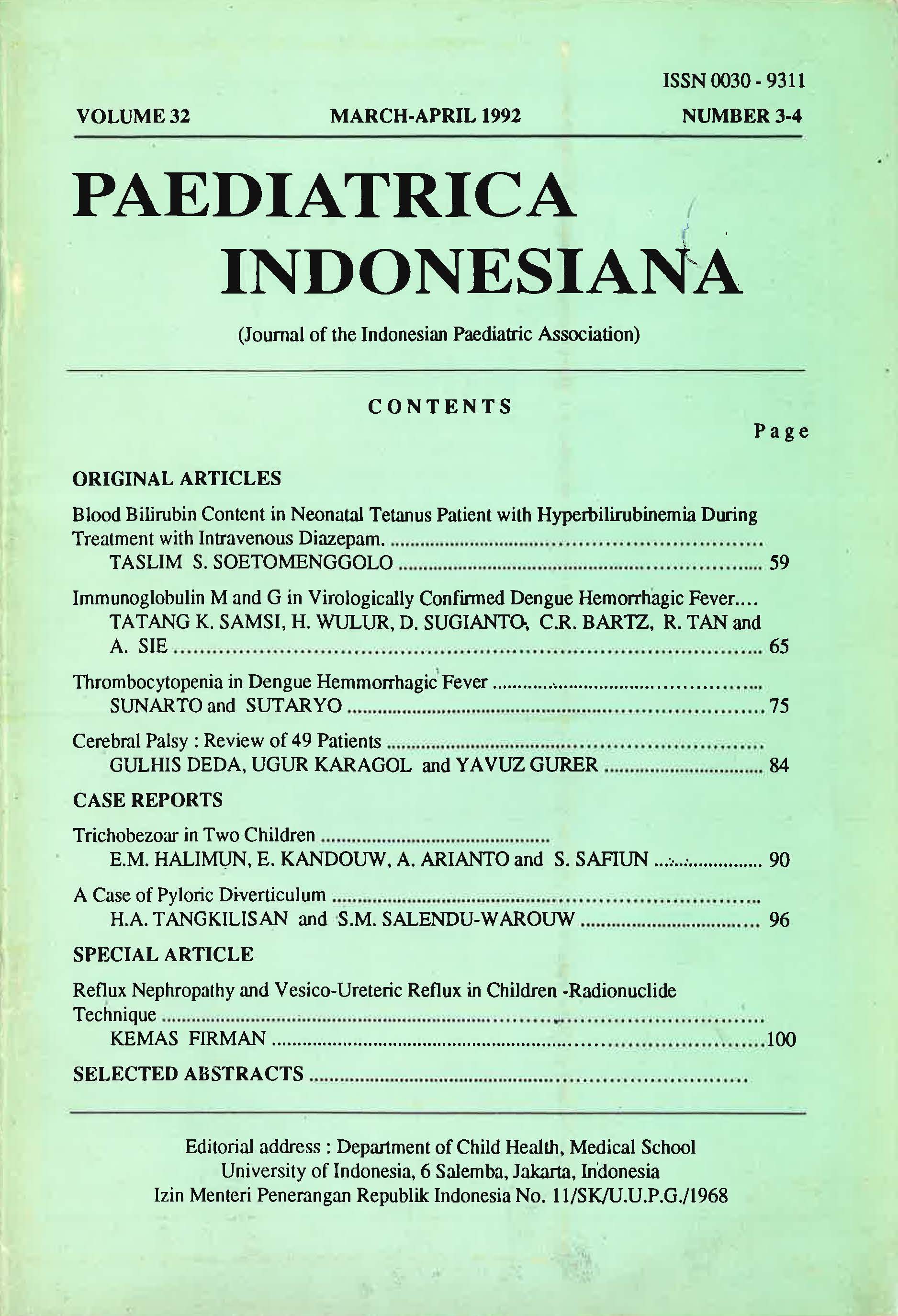Blood Bilirubin Content in Neonatal Tetanus Patient with Hyperbilirubinemia during Treatment with Intravenous Diazepam
Abstract
An evaluation on 128 neonatal tetanus patients with hyperbilirubinemia was done at the Department of Child Health, Dr. Cipto Mangunkusumo General Hospital, Jakarta. The patients were treated with high dosages of diazepam intravenously. This drug is potential to cause the increase of blood bilirubin, and in turn this latter condition is potential to cause kernicterus.
Of the 128 patients there were 70 males and 58 females. The age of the patients were mostly (79.6 %) 4- 7 days.
Fourteen of the 128 patients showed the increase of their blood bilirubin content during the second day of treatment, but after that it declined gradually during the next 3 days. The mortality of the 14 patients was 8 (57.1 %), so far no kernicterus was recorded among them.
Among the 128 patients, 114 patients showed the decrease of their blood bilirubin content during the treatment. During 3 days the blood bilirubin content became less than 10 mg/dL. No kernicterus was recorded among those patients.
It was concluded that intravenous diazepam is not dangerous in patients with mild and moderate hyperbilirubinemia, and no kernicterus was recorded during evaluation.
References
2. Gastaut H, Naguet R, Poire R, Hassinari CA. Treatment of status epilepticus with diazepam. Epilepsia 1965; 6: 167-82.
3. Hendrickse RG, Sherman PM. Tetanus in childhood :Report of a therapeutic trial of diazepam. Br. Med.J. 1966; 2: 860-1.
4. Parsonage MJ, Norris LA. Use of diazepam in treatment of severe convulsive status epilepticus. Br. Med J.l967; 3:85-8.
5. Kazim E. Diazepam in tetanus. Lancet 1965; 1: 1162-5.
6. Liem WT, Darmawan S,lsmael S, Sudigbia I, Suradi R, Munthe BG. The effect of diazepam on tetanus. Paediatr. lndones.l970; 10:248-58.
7. Weinberg WA. Control of the neuromuscular and convulsive manifestation of severe systemic tetanus. Case report with a new drug, Valium. Clin. Pediat. 1964; 3:226-8.
8. Schiff D, Shan G, Stem L. Drug combinations and displacement of bilirubin from albumin. Pediatrics 1971; 48:139-41.
9. Nathens~n G, Cohen MI. Me Namara H. The effect of Na benzoate serum bilirubin of the Gunn rat. J. Pediatr. 1975; 86: 799-804.
10. Shirkey HC. Drug therapy. In: Nelson, Vaughan,Mc Kay, eds. Textbook of Pediatrics, 9th ed. Tokyo: B
Saunders, 1969: 233-312.
11. Shirkey HC. Tranquilizers. In: Shirkey, eds. Pediatric drug Handbook, 1st. ed. Philadelphia: WB Saunders, 1977: 176-83.
12. Volpe JJ. Bilirubin and brain injury. In Volpe eds. Neurology of the newborn. 1st. ed. Sydney: WB Saunders, 1981: 336-53.
13. Kliegman RM, Behrman RE. Jaundice and hyperbilirubinemia in the newborn. In: Behrman and Vaughan, eds. Nelson textbook of Pediatrics, 13"'. ed. Tokyo: WB Saunders, 1987:405-6.
14. Feigen RD. Tetanus. In Behrman and Vaughan, eds. Nelson textbook of Pediatrics, 13th. ed. Tokyo: WB Saunders, 1987: 617-20.
Copyright (c) 2019 Taslim S. Soeetomenggolo

This work is licensed under a Creative Commons Attribution-NonCommercial-ShareAlike 4.0 International License.
Authors who publish with this journal agree to the following terms:
Authors retain copyright and grant the journal right of first publication with the work simultaneously licensed under a Creative Commons Attribution License that allows others to share the work with an acknowledgement of the work's authorship and initial publication in this journal.
Authors are able to enter into separate, additional contractual arrangements for the non-exclusive distribution of the journal's published version of the work (e.g., post it to an institutional repository or publish it in a book), with an acknowledgement of its initial publication in this journal.
Published 2019-01-28













